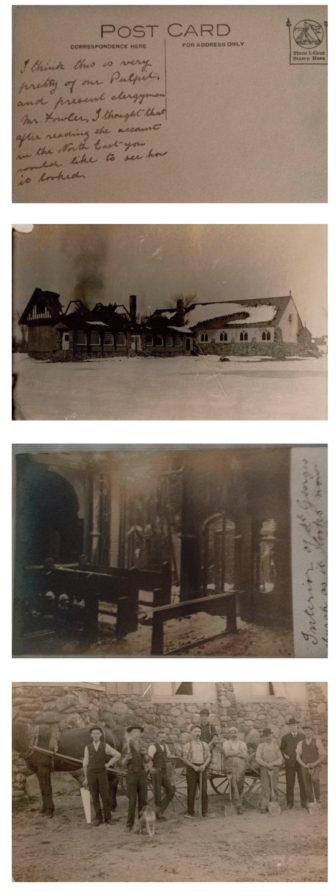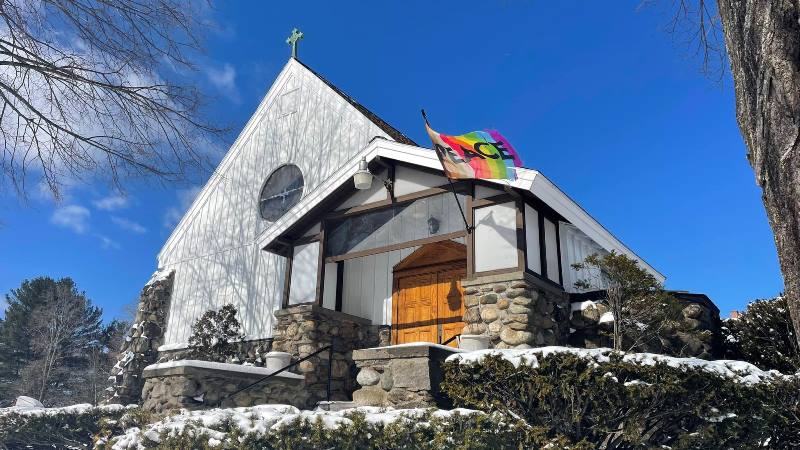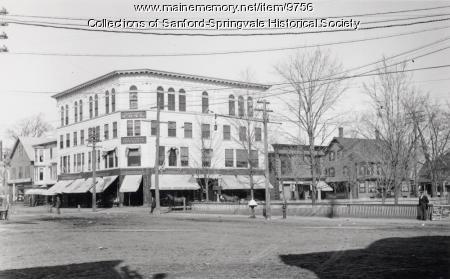History of St. George Episcopal Church see bottom of page for footnotes.
Some of the photos are courtesy of Barbara Bailey Kuzma. She is the granddaughter of Rev. Alanson Q. Bailey, who served as a deacon at St. George’s Mission from 1901-1902. Thank you Barbara, for these excellent items of history of our church.
The first services of St. George’s Episcopal Church were conducted in the Leavitt Block[1] in July, 1901, by the Rev. Hubert Pulsifer who reported to the 1902 Diocesan Convention that, “a great many English people are employed in the mills there (Sanford) and a large number of the church families have been found.” One of the mill owners, Thomas Goodall,[2] donated land to the church and money was raised to begin construction of the parish hall. Back in those days, the location was at the edge of Sanford. Today we are considered to be in the center of town.
St. Elizabeth’s Hall was opened at a special service on June 14, 1903. Work began on the church building in 1904. The church was consecrated on St. Bartholomew’s Day, August 24, 1906 by Bishop Robert Codman. Fire caused severe damage to the church and parish hall on February 1, 1908. With repairs completed, church services resumed on May 3, 1908 and the parish hall was back in use by the summer of 1909.[3]
The church underwent vigorous growth from 1918 to 1945 despite the great depression which caused serious problems for the town’s mills. During those years, St. George’s had an active adult choir, and thirty-five children were involved in a youth choir. Fr. E. Robert Newton began a long tenure at St. George’s in October of 1952. He served as Vicar for fourteen years and retired in November of 1966. It proved to be a difficult period because the mills closed in the early 1950s and 3,000 people lost their jobs.[4]
Subsequent to the retirement of Fr. Newton, there were four different priests and two interims who served us well from 1966 through 1985. During the 1970s the economies of Sanford and Biddeford were jolted by the textile industry’s further problems and it became necessary to “yoke” the congregation of St. George’s with that of Christ Church in Biddeford, an arrangement that lasted until 1981.[5]
After a long interim, the Rev. Linton H. Studdiford was called as Vicar of St. George’s Mission in August of 1985. The church thrived under his leadership and after eighty-one years as a mission, St. George’s was accepted as a parish at the 168th Diocesan Convention in Portland on May 16, 1987. Fr. Studdiford accepted a call to another parish in 1991. After an interim of a year and a half, Fr. William Schulyer was called in March of 1993 and celebrated his last Eucharist on January 28, 2007.
 Thus began an interim period until the Reverend Susan M. Murphy was called as our new rector and began ministry with us on May 1, 2008.
Thus began an interim period until the Reverend Susan M. Murphy was called as our new rector and began ministry with us on May 1, 2008.
St. George’s then began making plans for renewal and growth. We began using the Five Practices of Fruitful Congregations by Robert Schnase and a starting in the fall of 2009 we began a very active outreach program to children and teens in our community. The KIDS Supper Club for elementary children and “Gathering Grounds”, a teen coffee house, both addressed the need for skill building, encouraging resiliency in youth and providing a safe place for youth to meet. In the fall of 2010 we hired a part time youth ministry coordinator to assist with outreach to Sanford area teens and support for children and youth ministry in the parish.
Refurbishing of the Sanctuary and Nave, Kitchen and new flooring in St. Elizabeth’s Hall, new roofs with insulation and maintenance issues were attended to. The commitment to outreach for the greater Sanford area, Haiti and Honduran projects, and collaboration with the Sanford Strong Coalition has enabled St. George’s to be on the front line in community involvement.
Our collaboration with some area churches resulted in a yearly Communities Care Day where our neighbors who were having many challenges in their lives could come and be served with good food, many health checks, information about community resources, activities for children with take home books and stuffed animals, free haircuts, and the “free” store where regular clothing, new undies and socks for all ages, warm winter coats and batteries for smoke detectors were provided. 2017 was our fifth Communities care Day having served over 250+ folks each year. Lay participation in the worship life and ministries of the church is strong as we continue to grow spiritually and in numbers. We are truly blessed.
Rev. Murphy retired at 72 per canon law and concluded her ministry with St. George’s the summer of 2018. For a brief interim, the Reverend Jim Low presided and provided pastoral care until the Reverend Lauren Kay was called as rector and started serving at St. George’s July of 2019. They left the church in March 2023 and Fr. Steve Fales has been serving as interim rector until the next permanent rector is found.
History of Rectors and Priests at St. George’s Episcopal Church, Sanford, Maine
Rev. Cuthbert Fowler July 1905 – October 1910
Rev. Elbert B. Holmes 1910 – 1914
Rev. Victor O. Anderson 1914 – 1915
Rev. Harland H. Ryder 1915 – 1918
Rev. C. E. O. Nichols 1918 – 1927
Rev. A. Harold Plummer 1927 – 1936
Rev. Peter P. B. Franklin 1936 – 1941
Rev. Daniel H. E. Fox 1941 – 1945
Rev. Alan McKinley 1945 – 1952
Rev. E. Robert Newton 1952 – 1966
Rev. Merle M. Smith 1966 – March 1968 (1)
 Rev. G. Stackley Hurst 1968 – 1974
Rev. G. Stackley Hurst 1968 – 1974
Rev. Edward R. Green 1974 – 1981 (2)
Rev. Richard Pease Interim 1981 – 1982
Rev. Philip Houghton 1983
Rev. Robert DeWolfe Interim Dec.1983 – July 1985 (3)
Rev. Linton Studdiford Aug.1985 – Jan. 1992 (4)
Rev. David C. Glendinning Interim Jan. 1992 – Feb.1993
Rev. William K. Schuyler March 1993 – Jan. 2007
Rev. George A. Lambert Interim March 2007 – April 2008
Rev. Canon Susan M. Murphy May 2008 – June 2018 (5)
Rev. Jim Low Temp. Priest-in-Charge Jan 2019-July 2019
Rev. Lauren Kay July 2019 – March 2023 (6)
Father Steve Fales April 2023- present
Notes:
(1) Killed in a private plane crash at Sanford Airport
(2) Green served St. George’s at 7:30am and 11:00am each Sunday and Christ Church, Biddeford, at 9:00am
(3) DeWolfe held one service weekly on Sunday at 10:30AM.
(4) When Fr. Studdiford was called to the mission, one Eucharist was held at 10:00am until December 13, 1987 (The Third Sunday of Advent) when an early Eucharist was added at 8:00am
(5) Murphy retired at age 72 as per Church Canon Law
(6) The physical church building was closed during the height of the Covid-19 pandemic and the congregation worshiped online from March 15, 2020 through May, 2021. Kay held one weekly service at 9am through the pandemic online and when we returned to the church building in 2021. Two services at 8 and 10am returned in November, 2022.
Additional Sanford History Sources:
https://sanford.govoffice.com/townhistory?&pri=0
https://www.achp.gov/preserve-america/community/sanford-maine
 [1] Leavitt Block was at the corner of Washington and School Streets, built 1901. Among the advertisements visible in the Leavitt building are “Leavitt’s Hall Dance Every Saturday Night,” “Frank C. Leavitt Coal,” “George P. Chase Insurance,” and “Davis Sewing Machines.” At the front corner of the block is George G. Brown & Co. Druggists. Just to the left of the Leavitt block is Trafton Brothers. On the right of the photo a man can be seen standing near two theatrical posters advertising Why Girls Go Wrong and The Pauline Hammond Company. This is a print from a 6″ x 8″ glass negative. (Caption from photo found at https://www.vintagemaineimages.com/artifact/9756/cart) Frank C. Leavitt built a business block in Sanford in 1901 to replace the earlier Leavitt Block destroyed by fire in 1899. Mr. Leavitt’s business interests covered a wide field. He sold coal, owned the Sanford Pharmacy, was the agent for York County for Studebaker automobiles, and at one time ran a hack and delivery business. Motion pictures were first shown in Sanford in 1908 in the hall on the fourth floor of Mr. Leavitt’s theater. The venture was so popular that Mr. Leavitt soon converted one of his two Main Street stores into a movie house which he called the Theatre Comique. In 1910 he built the 1,300 seat Leavitt Theatre to replace Theatre Comique. (caption from https://www.vintagemaineimages.com/artifact/21501/cart) The Leavitts, who moved from Alfred to Sanford in the early 1890s, built this commercial block at the corner of Washington and School Streets. The Leavitt Block was built on the site of the old Sanford Post Office and as soon as the new building was completed, the new post office occupied the corner portion of the building. (https://www.mainememory.net/artifact/22944)
[1] Leavitt Block was at the corner of Washington and School Streets, built 1901. Among the advertisements visible in the Leavitt building are “Leavitt’s Hall Dance Every Saturday Night,” “Frank C. Leavitt Coal,” “George P. Chase Insurance,” and “Davis Sewing Machines.” At the front corner of the block is George G. Brown & Co. Druggists. Just to the left of the Leavitt block is Trafton Brothers. On the right of the photo a man can be seen standing near two theatrical posters advertising Why Girls Go Wrong and The Pauline Hammond Company. This is a print from a 6″ x 8″ glass negative. (Caption from photo found at https://www.vintagemaineimages.com/artifact/9756/cart) Frank C. Leavitt built a business block in Sanford in 1901 to replace the earlier Leavitt Block destroyed by fire in 1899. Mr. Leavitt’s business interests covered a wide field. He sold coal, owned the Sanford Pharmacy, was the agent for York County for Studebaker automobiles, and at one time ran a hack and delivery business. Motion pictures were first shown in Sanford in 1908 in the hall on the fourth floor of Mr. Leavitt’s theater. The venture was so popular that Mr. Leavitt soon converted one of his two Main Street stores into a movie house which he called the Theatre Comique. In 1910 he built the 1,300 seat Leavitt Theatre to replace Theatre Comique. (caption from https://www.vintagemaineimages.com/artifact/21501/cart) The Leavitts, who moved from Alfred to Sanford in the early 1890s, built this commercial block at the corner of Washington and School Streets. The Leavitt Block was built on the site of the old Sanford Post Office and as soon as the new building was completed, the new post office occupied the corner portion of the building. (https://www.mainememory.net/artifact/22944)
[2] Thomas Goodall, was a textile industrialist in Sanford. He was born in Dewsbury, Yorkshire, England, September 1, 1832. He was orphaned at age three, and apprenticed in woolen manufacturing at age eleven. He was placed in charge of the establishment at age seventeen and came to the United States in 1846. After spending short periods in various places around New England, Mr. Goodall settled in Troy, New Hampshire where he first engaged in the manufacture of satinets and beavers. According to local historical accounts, one day Mr. Goodall observed a farmer struggling to secure a blanket on a horse, when he realized there was a market opening for horse blankets. He produced bales of them for the Union Army. Mr. Goodall sold his business in Troy and returned to England with the intent of retiring. After just a few years he returned to the U.S. looking for new opportunities and settled in Sanford in October 1867. By the time Mr. Goodall passed away in 1910, Sanford’s population had risen dramatically and the mills were producing some of the finest textiles in the world. (https://www.mainememory.net/artifact/21513) Thomas Goodall (1832 – 1910) was an entrepreneur who established an important textile mill in Sanford in 1867. The Sanford Mills are credited with allowing Sanford to achieve significant growth during the latter part of the 19th century. Goodall was born in Dewsbury, Yorkshire, England, on September 1, 1832. His original textile business in Troy, New Hampshire produced (among other things) horse blankets which he supplied in great quantities to the Union Army during America’s Civil War. After a brief retirement and a return to England, Goodall returned to America and established the Goodall Mill in Sanford. He lived in Sanford for the rest of his life, seeing the Sanford Mills, and the town itself, thrive. Ultimately the Sanford Mills were producing some of the finest textiles in the country. Goodall died in Sanford in 1910. (https://www.waymarking.com/waymarks/wm9376_Thomas_Goodall_Sanford_Maine)
[3] Article from “The Churchman” February 8, 1908, p 190. (Screenshot from Google Books)
[4] The Goodall family operated the mills until 1953, when they sold them to the Burlington Mills Corporation. Burlington shut the mills down in 1955. (https://en.wikipedia.org/wiki/Sanford_Mills_Historic_District) Incorporated in 1768, Sanford remained a farming and logging community until the arrival of British industrialist Thomas Goodall in 1867. The woolen textile complex Goodall and his sons built fueled the town’s prosperity for nearly a century. The mills created carriage robes, carpets, draperies, auto fabrics, armed service uniforms, and material for men’s and women’s clothing. The wealth and philanthropy of Goodall led to the construction of Sanford Town Hall, the Sanford Unitarian Church, Lewis B. Goodall Library, H.D. Goodall Hospital, Oakdale Cemetery, Goodall Park, and the Sanford Country Club. When the mills left in 1954, a third of the town’s population was thrown out of work, almost overnight. A spirited effort to recruit new industry led to several new businesses and a nickname immortalized by Life magazine in 1965: “The Town that Refused to Die.” (https://www.achp.gov/preserve-america/community/sanford-maine)
[5] The liberal arts Nasson College closed in the early 1980s, draining cultural vitality from the community. In the 1990s, globalization robbed the town of much of its remaining manufacturing base.

